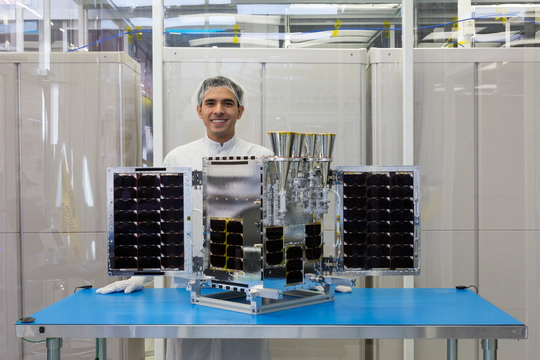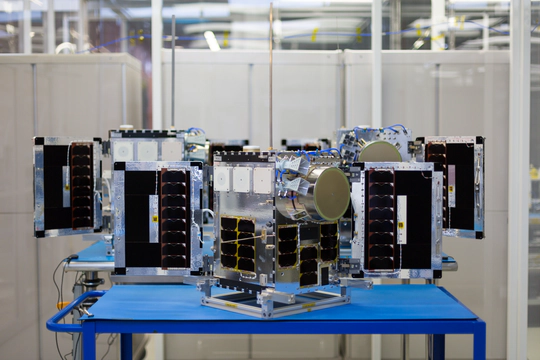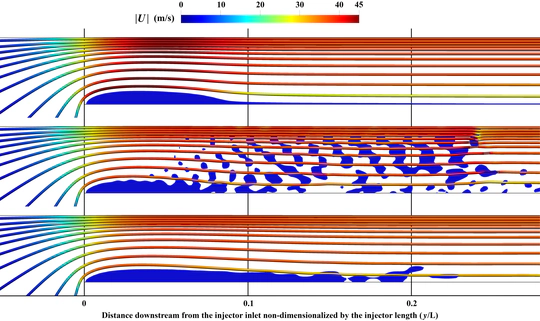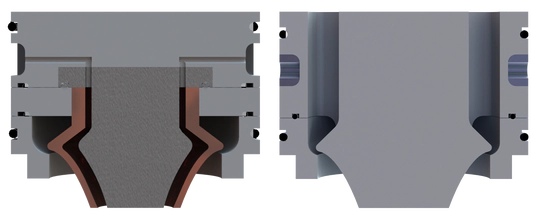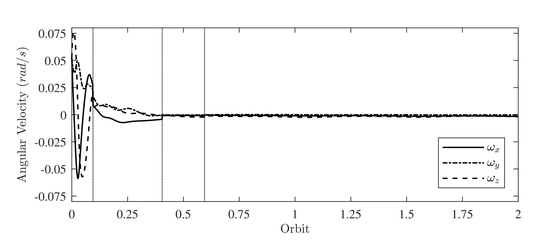Emerson Vargas Niño
Aerospace Engineer and Educator
Emerson Vargas Niño is currently a Guidance, Navigation and Control Engineer at Astroforge. Emerson has been developing solutions and leading teams for over 9 years to create GNC, propulsion, structures and avionic systems for over 10 rockets and 45 satellites, with more than 25 currently in orbit.
Core Experience
- Developed robust GNC flight software in Rust for a deep space asteroid mining spacecraft, implementing state estimation, control, and other key flight algorithms, validated through hardware-in-the-loop (HIL) and software-in-the-loop (SIL) testing, working as part of a three-person team to take the system from initial concept to flight-ready in 9 months
- Built 6-DOF Monte Carlo simulation framework in Python/C++ for SIL testing of GNC stack, running 55x faster than real-time
- Developed Monte Carlo tests to evaluate GNC performance, identifying issues and implementing improvements across the GNC stack
- Serving as one of two GNC operators for mission control during spacecraft launch and operations, responsible for commissioning, commanding and automating system checkouts
- GNC engineer responsible for design, on-orbit operations and testing functions across 45+ small satellites in 10+ missions
- Developing & testing resistojet propulsion system; created Python simulation of propellant phase change inside heat chamber in 1 month
- Conducted on-orbit commissioning, conjunction assessment, collision avoidance, formation flying and GNC calibration for 20+ spacecraft
- Owned GNC hardware for 35+ spacecraft end-to-end, led acceptance & calibration tests, achieving 100% on-orbit success
- Leading 5+ members to execute projects, including pump CFD simulations and cooling jacket design, to aid a turbopump design
- Developed a Python-based spacecraft simulation framework to optimize attitude trajectories and sensor placements, increasing yearly useful satellite observations by 35% for 6 orbiting spacecraft
- Developed on-orbit calibration methods & cut average GNC commissioning time by 40% via automation of GNC & data processing tasks
- Developed hardware and software automation tools, leading to a 60% reduction in GNC hardware acceptance campaign duration
- Developed and validated a Python & STK tool to devise deorbiting strategies, informing all SFL spacecraft designs from 2023 onwards
- Advanced attitude trajectory algorithm from TRL-1 to TRL-9 by integrating it into flight code written in C, validating it via simulation and deploying it on-orbit to 2 spacecraft, resulting in 30% increase in star tracker availability during target-tracking
- Developed dynamic set-point determination technique for reaction wheel angular momentum using numerical optimization, achieving 10% average reduction in pointing error and 20% increase in momentum margin for attitude maneuvers on 10 active spacecraft
- Led qualification and acceptance testing of deployable solar panel system on 15+ spacecraft, achieving TRL-9 and 100% on-orbit success
- Conducted studies and designed solutions to overcome lifetime and efficiency challenges in monopropellant and Hall thruster programs
- Managed 5+ member team through 3 cold flow tests and a 35-second hot fire test on a 1,000 lb thrust LOX-kerosene engine
- Spearheaded the University of Toronto’s first liquid rocket engine project, leading a remote team of 14 students in designing a 110 lbf thrust N2O-ethanol engine, from project inception to completion of the preliminary design within 10-month timeframe
- Developed a Python-based rocket simulation , including the propulsion system and 3-DOF flight dynamics, successfully validating apogee predictions against alternative tools and leveraging numerical optimization to achieve 15% reduction in vehicle mass
- Led international team of 10+ students from two universities in designing a 1,900 lbf thrust N2O-ethanol liquid rocket engine for a rocket aimed at reaching space (390,000 ft apogee), from the team’s inception to completion of the preliminary design phase
- Led 20+ member team in the design and implementation of a 1,400 lbf thrust N2O-paraffin hybrid rocket engine which propelled the rocket DEFIANCE to 21,000 ft, securing 1st place in the Advanced Flight category at the 2022 Launch Canada competition
- Designed engine’s injector, creating MATLAB and OpenFOAM CFD simulations, executed on HPC cloud clusters, achieving 3.9% error in simulating two-phase N2O mass flow. Results published in the AIAA Propulsion and Energy Forum proceedings and used as a resource in Stanford’s graduate-level Advanced Rocket Propulsion course
- Developed and validated rocket structural loading models at max-Q using Python and OpenFOAM CFD simulations , executed on the Niagara supercomputer, leading to 12" reduction in propellant tank length to ensure 2x safety factor during flight
- Created 6-DOF spacecraft simulation with environmental disturbances in MATLAB to study B-dot and optimal magnetic-impulsive control
- Led team of 4 on the design, analysis and integration of a N2O-cooled aerospike nozzle into a small-scale hybrid rocket engine
- Developed optimization-based design process to reduce heat loads and maintain thrust, presenting results at CASI ASTRO conference
- Supported the life cycle of 5+ mobile computing and robotics solutions, encompassing design, prototyping, ensuring compliance with program requirements and completion of test procedures, alongside providing software support for the requirements management tool
- Led 6-person team to develop 5 IoT solutions, including a meeting productivity hub deployed across Zebra campuses worldwide
- Designed and built hardware and software for interactive electronic art installation at Nuit Blanche, attracting 7,000+ visitors in 12 hours
- Organized and conducted statistical analysis on distracted driving video & numerical data, co-authoring final report for industry partner
- Designed, analyzed, manufactured & tested components for 4 rockets, and aided 3 successful hot-fire and cold-flow test campaigns
Additional Experience
- Invited member due to exceptional contributions, shaping organizational strategy and implementing innovative ideas at Pueblo Science
- Facilitated team in overcoming challenges in the design, testing, construction and launch of hybrid and liquid rockets
- Top-requested STEM instructor, developing & delivering engaging classes to 100+ grade 5-9 students in remote Indigenous communities
- Creating coding and electronics STEM curriculum modules for hundreds of rural grade 7-11 students across the Global South
- Developed and delivered weekly, hands-on STEM programs to 30+ students aged 8-12 from marginalized low-income communities, earning recognition as top 10% facilitator; chosen as interim program facilitator to lead 10+ volunteers to deliver engaging programming
- Delivered STEM talks and workshops to hundreds of youth at venues including Ontario Science Centre, Science Rendezvous, TEDxYouth
- Managed and expanded a sponsorship portfolio valued over $110K USD in cash contributions and $11M USD in in-kind donations
- Led visibility campaign, boosting social media engagement by 4000%, contributing to a $26K USD yearly funding referendum success
Projects
Currently Under Development
Education
- GPA: 3.95/4.00
- Fully-funded tuition & stipend from UofT Student Fellowship
- Thesis: Microsatellite Development, Testing and On-Orbit Operation
- Thesis Supervisor: Prof. Robert E. Zee
Click to view Thesis Abstract
A recent rise in the number of small spacecraft has motivated the development of the DEFIANT microsatellite platform at the Space Flight Laboratory. This thesis details the development of multiple spacecraft subsystems for the DEFIANT platform, including the guidance, navigation and control, propulsion and deployable solar panel subsystems. The testing process for spacecraft hardware is presented and used in the qualification and acceptance of several subsystems for the DEFIANT platform. Finally, developments in the on-orbit operation of the guidance, navigation and control subsystem are detailed and used in the commissioning of several spacecraft. The work outlined in this thesis was used in the design, analysis, testing, and commissioning of over 20 spacecraft for the Space Flight Laboratory, supporting its competitive advantage in the microsatellite world market.
- Streams: Mechatronics, Solid Mechanics & Design
- Thesis: Optimal Hybrid Attitude Control for Detumbling Spacecraft
- Thesis Supervisor: Prof. Christopher Damaren
Click to view Thesis Abstract
The B-Dot controller, a traditional method of detumbling is revisited and compared against a recently developed hybrid method which utilizes a magnetic-impulsive controller developed through modern optimal control theory in order to compensate for inherent uncontrollability found in purely magnetic control. A number of simulations were performed in order to compare the performance of the two systems over a range of conditions including differing orbital altitudes and methods for impulse application time.
- Capstone: Hybrid Rocket Aerospike Nozzle Design
- Capstone Supervisors: Prof. Masayuki Yano and Mr. Adam Trumpour
Click to view Capstone Abstract
UTAT has requested the investigation of aerospike nozzle due to their proven efficiency advantages over conventional bell nozzles. Despite their inherent advantages, UTAT has been reluctant to explore this concept in the past due to significant challenges associated with their implementation. In specific, aerospike nozzles are notoriously challenging to cool and integrate with engine assemblies. This paper presents a detailed method for the design and analysis of an aerospike nozzle following the example of a nozzle designed for use on a small scale test stand. Processes for judiciously choosing the engine parameters, designing the nozzle contour, applying cooling analysis, optimizing the contour, completing the mechanical design, and analyzing an aerospike nozzle using modern computational methods are explained in detail. In addition, a cost, safety, and environmental analysis is performed for the example nozzle. Furthermore, a comparison of aerospike engine performance versus that of a conventional bell nozzle reveals that a scaled up version of the example test stand nozzle could be expected to be operate with an average efficiency of approximately 4% better than a the conventional bell nozzle currently in use by UTAT’s flagship rocket, Defiance.
Skills & Interests
Computer Langugages
Rust, Python, C++, C, MATLAB, Bash/Shell,
Languages
Fluent: Spanish, English
Novice: German, French
Tools
GNU/Linux, STK, OpenFOAM, ANSYS (Fluent and Mechanical), SolidWorks, Pointwise, Git, high-performance computingFabrication
Lathe & mill (3 George Brown College certificates), soldering, 3D printing, composite layups (carbon fiber & fiberglass)Interests
Continuing education courses, backcountry backpacking, scuba diving (PADI certified), rock climbing, skateboarding, swimming, running, meditating, photography, violin, guitar, world citizen (visited 30+ countries, lived in 6)Contact
Interested in collaborating or sharing ideas about aerospace, STEM education, art or something else? I’m all ears! Drop me a message, and let’s start a conversation.

